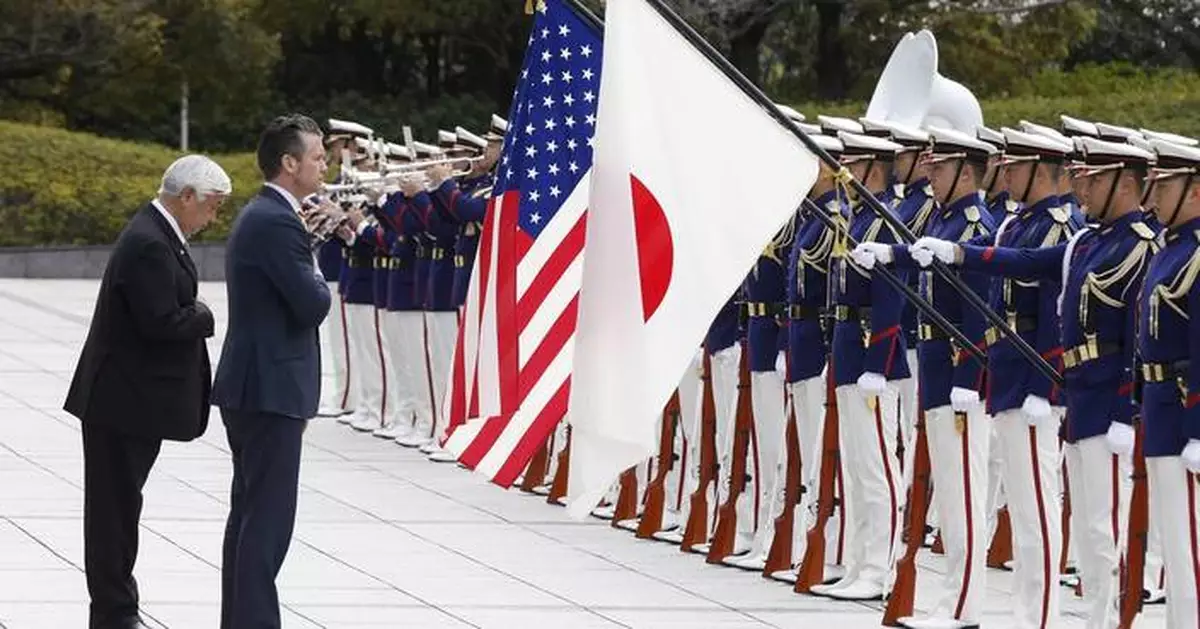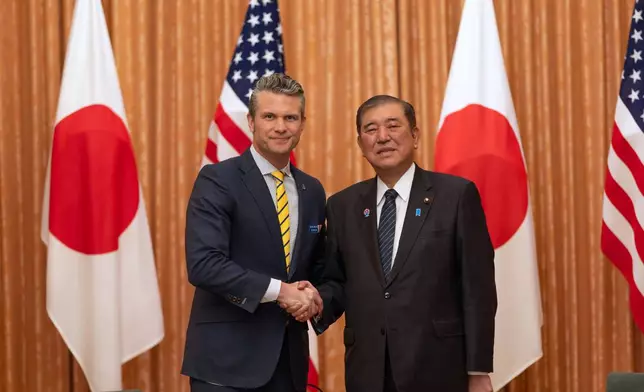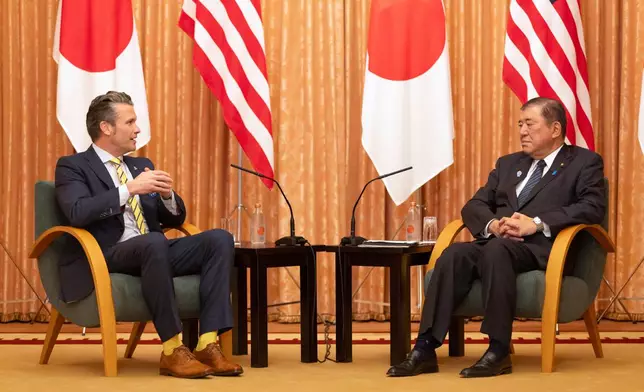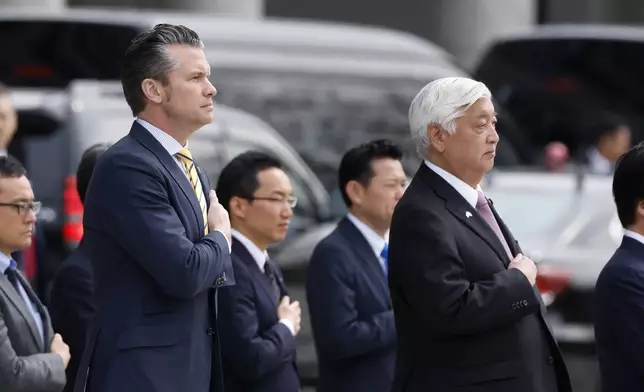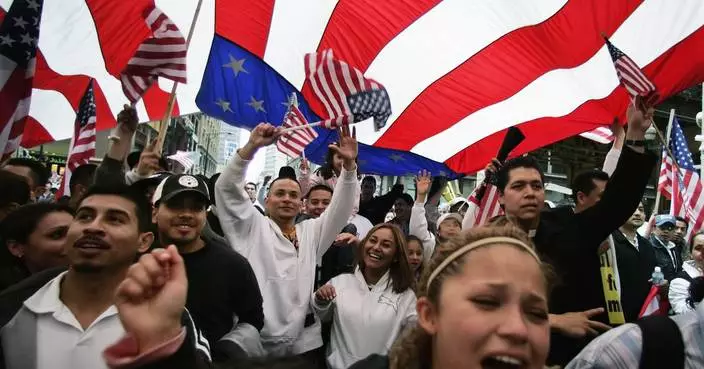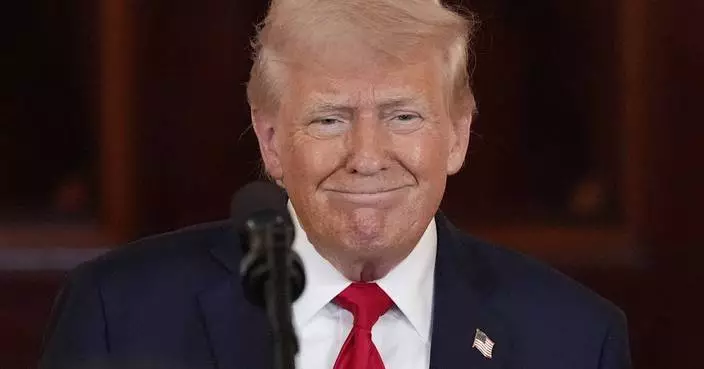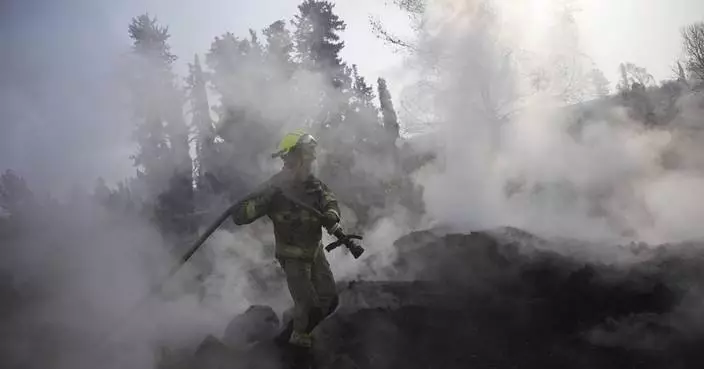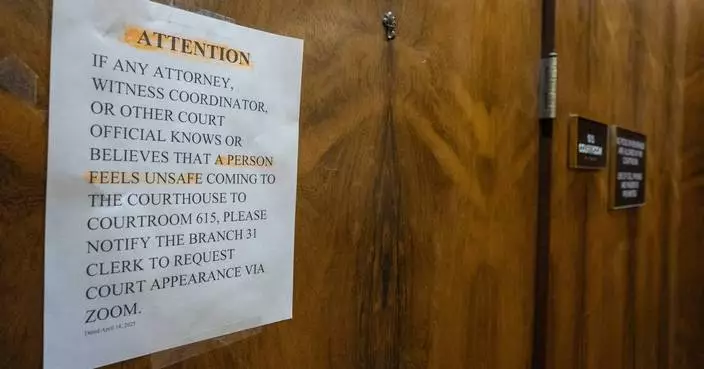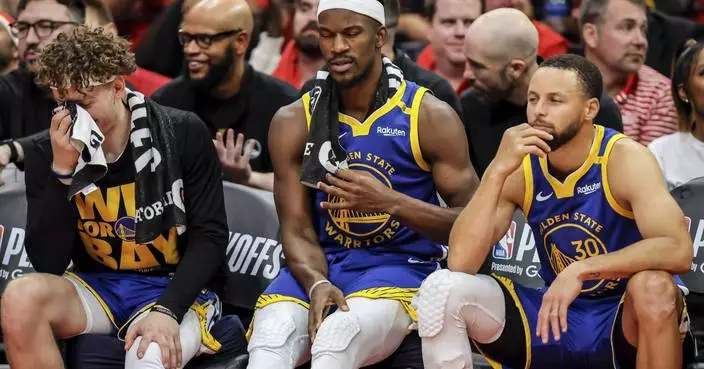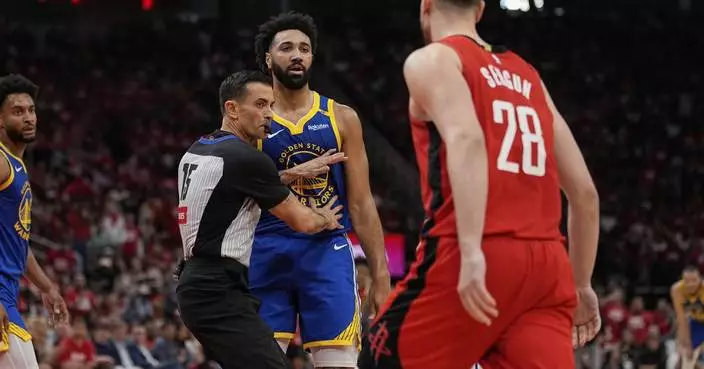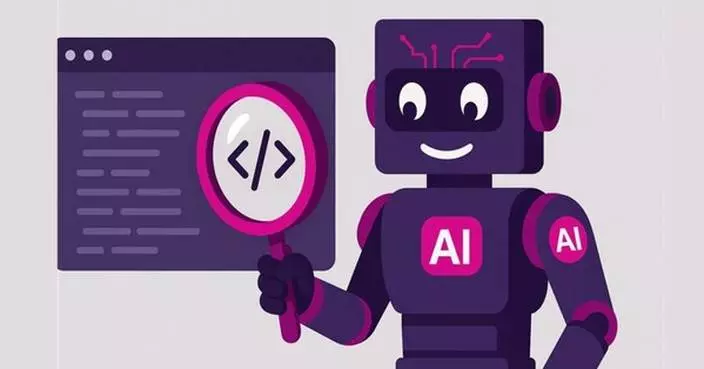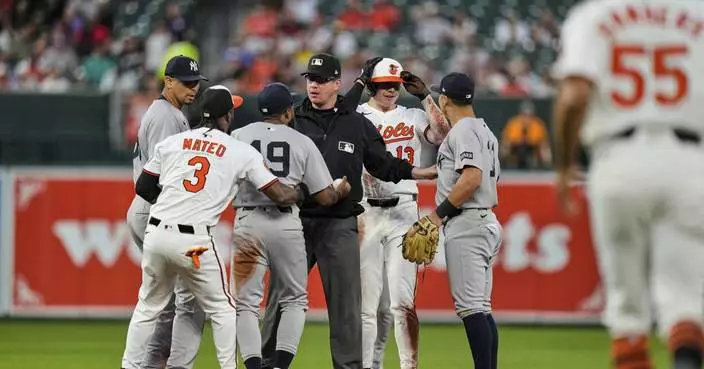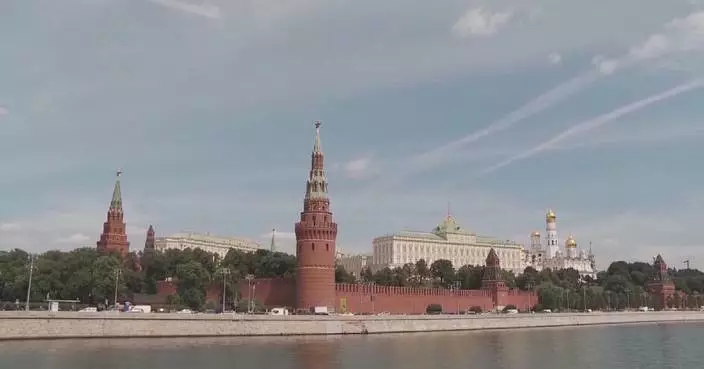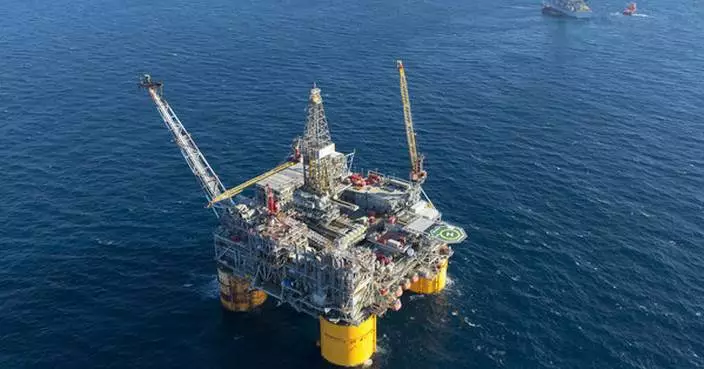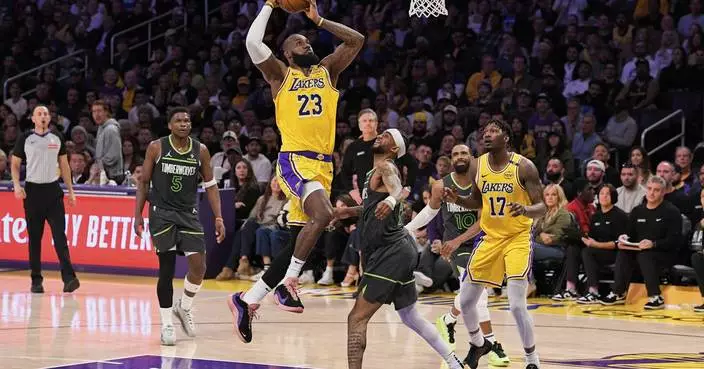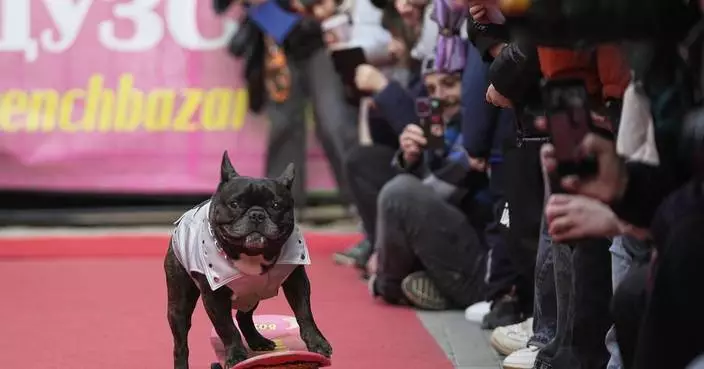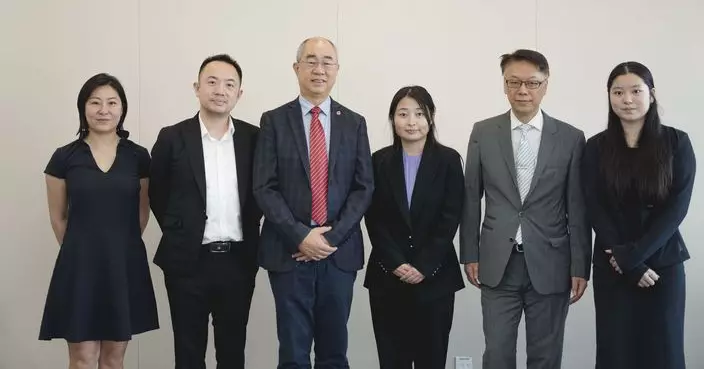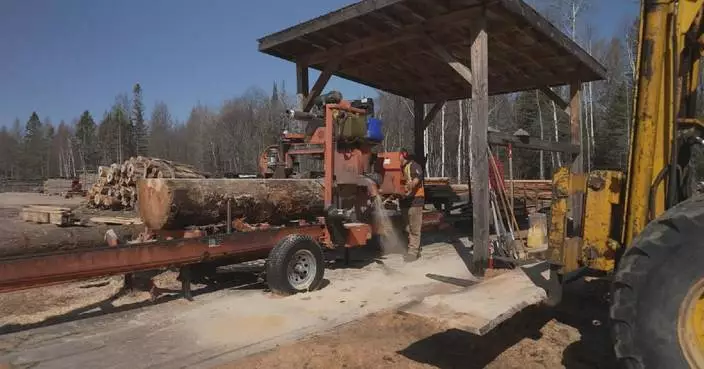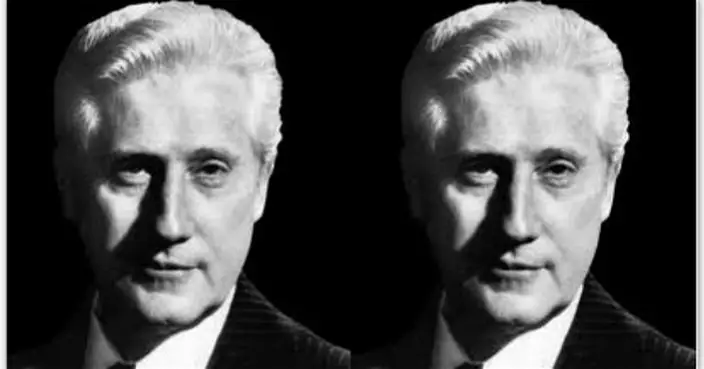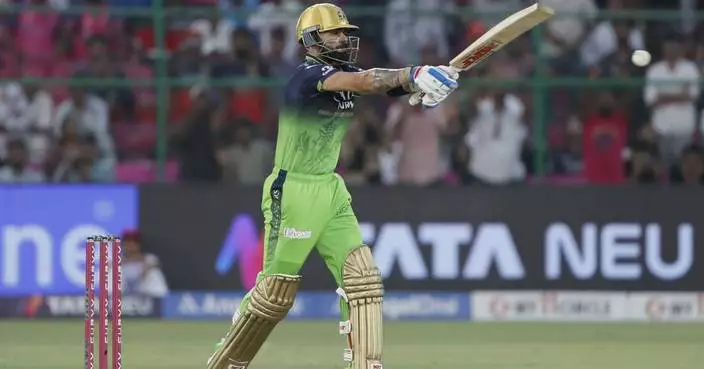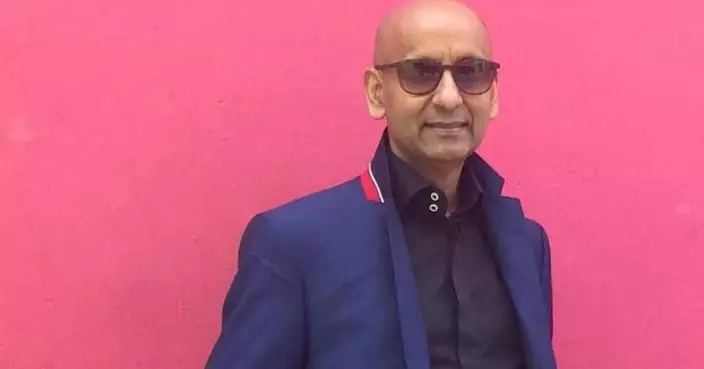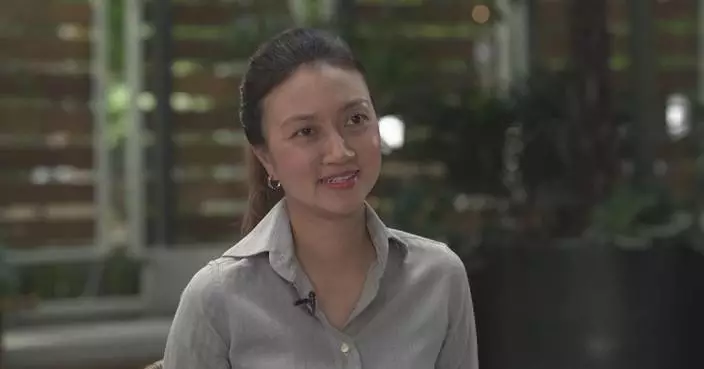TOKYO (AP) — U.S. Defense Secretary Pete Hegseth called Japan on Sunday an "indispensable partner" in deterring growing Chinese assertiveness in the region and announced upgrading the U.S. military command in Japan to a new "war-fighting headquarters."
Hegseth, who is on his first Asia trip with Japan as his second stop, also stressed the need for both countries to do more to accelerate the strengthening of their military capability as the region faces China’s assertive military actions and a possible Taiwan emergency.
Click to Gallery
U.S. Secretary of Defense Pete Hegseth gives his opening speech at the beginning of his meeting with Japanese Prime Minister Shigeru Ishiba at the prime minister's office in Tokyo Sunday, March 30, 2025. (Stanislav Kogiku/Pool Photo via AP)
U.S. Secretary of Defense Pete Hegseth, center left, shakes hands with Japanese Prime Minister Shigeru Ishiba at the prime minister's office in Tokyo Sunday, March 30, 2025. (Stanislav Kogiku/Pool Photo via AP)
U.S. Secretary of Defense Pete Hegseth, left, shakes hands with Japanese Prime Minister Shigeru Ishiba at the prime minister's office in Tokyo Sunday, March 30, 2025. (Stanislav Kogiku/Pool Photo via AP)
U.S. Secretary of Defense Pete Hegseth, left, gives his opening speech at the beginning of his meeting with Japanese Prime Minister Shigeru Ishiba at the prime minister's office in Tokyo Sunday, March 30, 2025. (Stanislav Kogiku/Pool Photo via AP)
U.S. Secretary of Defense Pete Hegseth, left, shakes hands with Japanese Prime Minister Shigeru Ishiba at the prime minister's office in Tokyo Sunday, March 30, 2025. (Stanislav Kogiku/Pool Photo via AP)
Japan's Defense Minister Gen Nakatani, right, and U.S. Secretary of Defense Pete Hegseth attend a joint news conference at the Ministry of Defense in Tokyo Sunday, March 30, 2025. (Kiyoshi Ota/Pool Photo via AP)
Japan's Defense Minister Gen Nakatani, right, and U.S. Defense Secretary Pete Hegseth, second left, meet at the Ministry of Defense in Tokyo Sunday, March 30, 2025. (Kiyoshi Ota/Pool Photo via AP)
Japan's Defense Minister Gen Nakatani speaks with U.S. Defense Secretary Pete Hegseth, unseen, during their meeting at the Ministry of Defense in Tokyo Sunday, March 30, 2025. (Kiyoshi Ota/Pool Photo via AP)
U.S. Defense Secretary Pete Hegseth speaks with Japan's Defense Minister Gen Nakatani during their meeting at the Ministry of Defense in Tokyo Sunday, March 30, 2025. (Kiyoshi Ota/Pool Photo via AP)
Japan's Defense Minister Gen Nakatani, right, and U.S. Defense Secretary Pete Hegseth shake hands while posing for photographs prior to their meeting at the Ministry of Defense in Tokyo Sunday, March 30, 2025. (Kiyoshi Ota/Pool Photo via AP)
Japan's Defense Minister Gen Nakatani, right, and U.S. Defense Secretary Pete Hegseth meet at the Ministry of Defense in Tokyo Sunday, March 30, 2025. (Kiyoshi Ota/Pool Photo via AP)
Japan's Defense Minister Gen Nakatani, center, and U.S. Defense Secretary Pete Hegseth, foreground, react after reviewing an honor guard during a welcome ceremony at the Ministry of Defense in Tokyo Sunday, March 30, 2025. (Kiyoshi Ota/Pool Photo via AP)
Japan's Defense Minister Gen Nakatani, left, and U.S. Defense Secretary Pete Hegseth, right, review an honor guard during a welcome ceremony at the Ministry of Defense in Tokyo Sunday, March 30, 2025. (Kiyoshi Ota/Pool Photo via AP)
Japan's Defense Minister Gen Nakatani, left, and U.S. Defense Secretary Pete Hegseth, right, review an honor guard during a welcome ceremony at the Ministry of Defense in Tokyo Sunday, March 30, 2025. (Kiyoshi Ota/Pool Photo via AP)
Japan's Defense Minister Gen Nakatani, right, and U.S. Defense Secretary Pete Hegseth review an honor guard during a welcome ceremony at the Ministry of Defense in Tokyo Sunday, March 30, 2025. (Kiyoshi Ota/Pool Photo via AP)
Japan's Defense Minister Gen Nakatani, left, and U.S. Defense Secretary Pete Hegseth review an honor guard during a welcome ceremony at the Ministry of Defense in Tokyo Sunday, March 30, 2025. (Kiyoshi Ota/Pool Photo via AP)
“Japan is our indispensable partner in deterring Communist Chinese military aggression,” Hegseth said at the beginning of his talks with Japan’s Defense Minister Gen Nakatani in Tokyo. "The US is moving fast, as you know, to reestablish deterrence in this region and around the world."
His comments come as an assurance at a time when Japan has been worried about how U.S. engagement in the region may change under President Donald Trump's “America First” policy, Japanese defense officials said, speaking on condition of anonymity, citing protocol. Trump has also threatened to impose trade tariffs on Japan, a key U.S. ally, sparking more concern.
The two sides agreed to accelerate plans to jointly develop and produce missiles such as Advanced Medium-Range Air to Air Missiles, or MRAAM, and consider producing SM-6 surface-to-air missiles, to help ease a shortage of munitions, Nakatani said. The ministers also agreed to speed up the process involving the maintenance of U.S. warships and warplanes in Japan to strengthen and complement Japanese and U.S. defense industries.
Japan and the U.S. decided in July to upgrade the command and control of the Japanese military as well as U.S. forces in the East Asian country, under the Biden administration, a major structural change aimed at bolstering joint operational and response capabilities. Japan is home to more than 50,000 U.S. troops.
Tokyo last week launched the Japan Joint Operations Command, or JJOC, whose mission is to coordinate Japanese Ground, Maritime and Air Self-Defense Forces, in a significant action to further strengthen capabilities to respond to contingencies and better cooperate with the U.S.
Hegseth announced Sunday the upgrading of its current command, U.S. Forces Japan, by placing a unified operational commander to function as a joint force headquarters to liaise with its Japanese counterpart to serve as “war-fighting headquarters” to bolster speed and capability of their troops’ joint operations.
The Pentagon chief said the reorganization of U.S. troops is a step to better prepare for a possible conflict. America and Japan both work for peace, but “we must be prepared,” he said.
The Japanese defense officials say they are not expecting a significant change in their responsibilities or an increase in U.S. troops in Japan.
Hegseth and Nakatani told a joint news conference that they have also agreed on the need to beef up Japan’s defense posture on the Southwestern islands, which are in critical locations along the disputed areas in the East China Sea and near Taiwan to further step up deterrence against China.
He stressed the need to have “sustaining, robust, ready and credible deterrence” in the Indo-Pacific, including across the Taiwan Strait, as “Japan would be on the frontlines of any contingency we might face in the western Pacific.”
China claims Taiwan as its own territory. The U.S. is obligated under a 1979 law to provide Taiwan with sufficient military hardware and technology to deter invasion, and its arm sales to Taiwan have always drawn strong opposition from Beijing.
On Saturday, he joined the U.S.-Japan joint memorial to honor the war dead in the Battle of Iwo Jima as they marked the 80th anniversary of the end of one of the fiercest battles of World War II, praising the strong alliance between the former enemies.
Before landing in Japan, Hegseth stopped in the Philippines where he also ensured Trump’s commitment to step up ties with the Southeast Asian country that faces maritime disputes with Beijing.
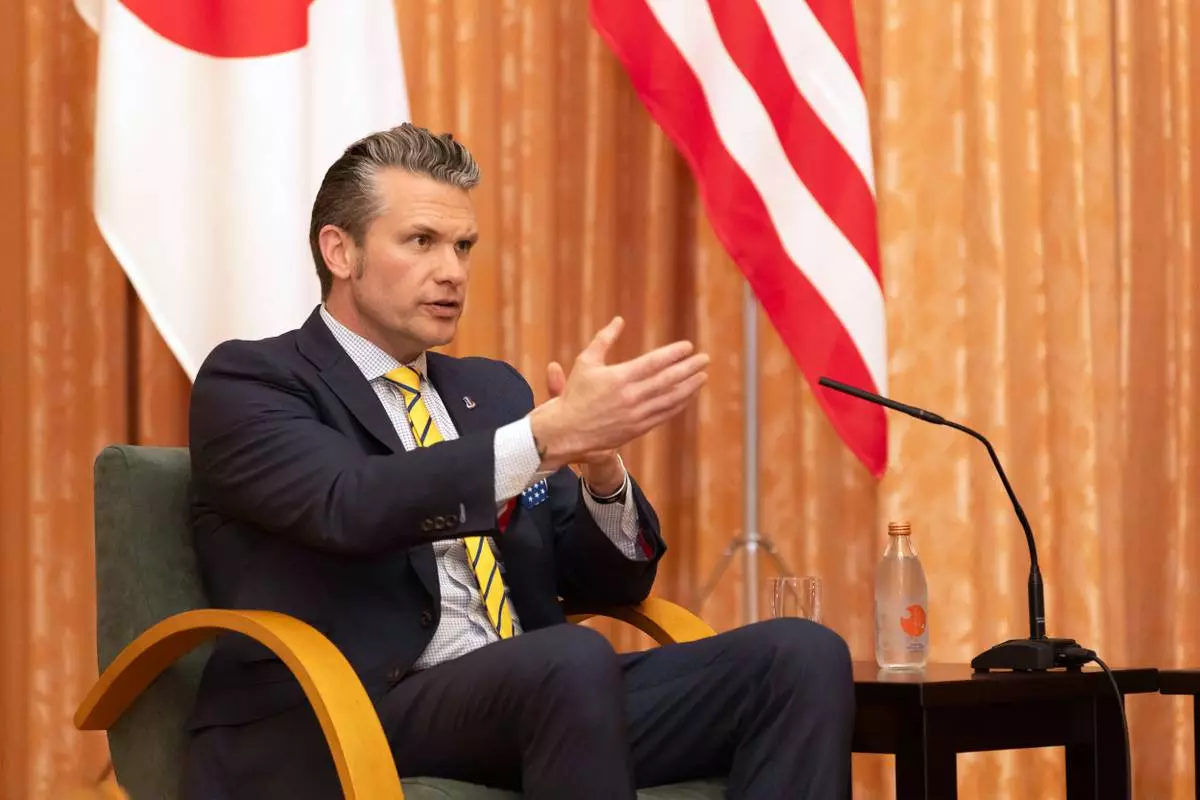
U.S. Secretary of Defense Pete Hegseth gives his opening speech at the beginning of his meeting with Japanese Prime Minister Shigeru Ishiba at the prime minister's office in Tokyo Sunday, March 30, 2025. (Stanislav Kogiku/Pool Photo via AP)
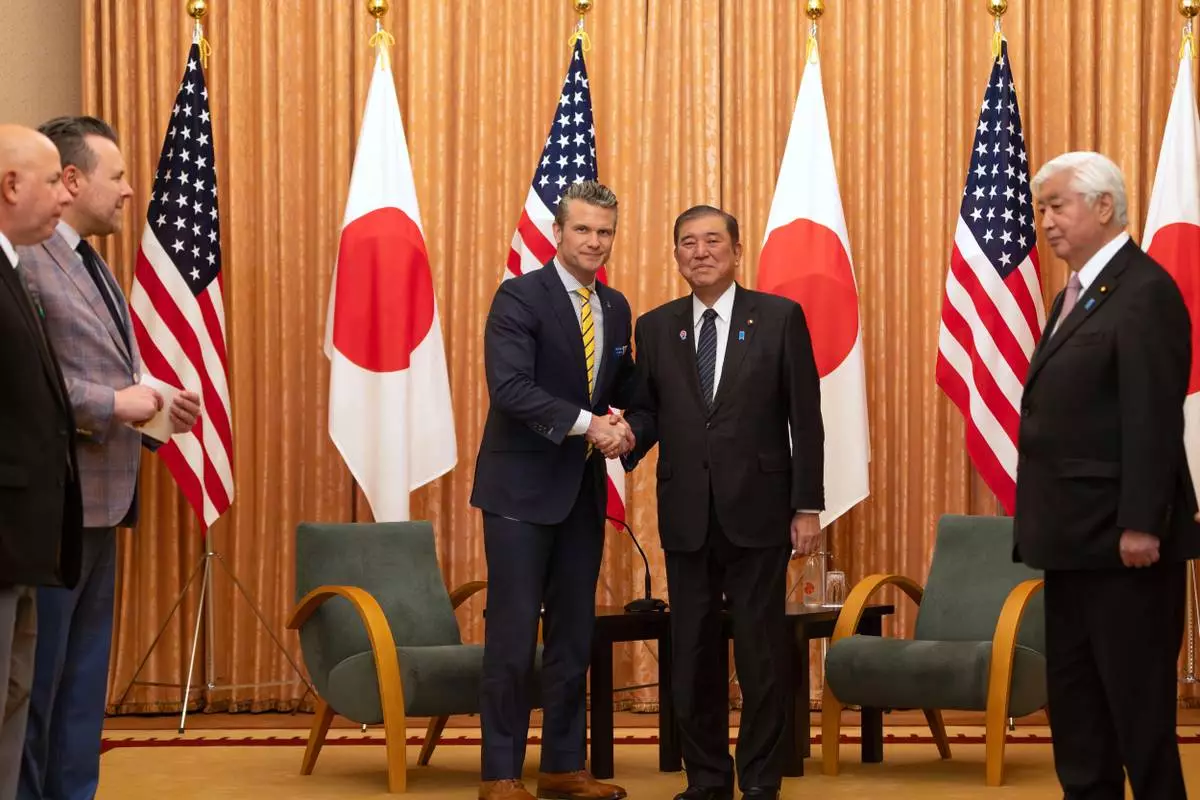
U.S. Secretary of Defense Pete Hegseth, center left, shakes hands with Japanese Prime Minister Shigeru Ishiba at the prime minister's office in Tokyo Sunday, March 30, 2025. (Stanislav Kogiku/Pool Photo via AP)

U.S. Secretary of Defense Pete Hegseth, left, shakes hands with Japanese Prime Minister Shigeru Ishiba at the prime minister's office in Tokyo Sunday, March 30, 2025. (Stanislav Kogiku/Pool Photo via AP)

U.S. Secretary of Defense Pete Hegseth, left, gives his opening speech at the beginning of his meeting with Japanese Prime Minister Shigeru Ishiba at the prime minister's office in Tokyo Sunday, March 30, 2025. (Stanislav Kogiku/Pool Photo via AP)
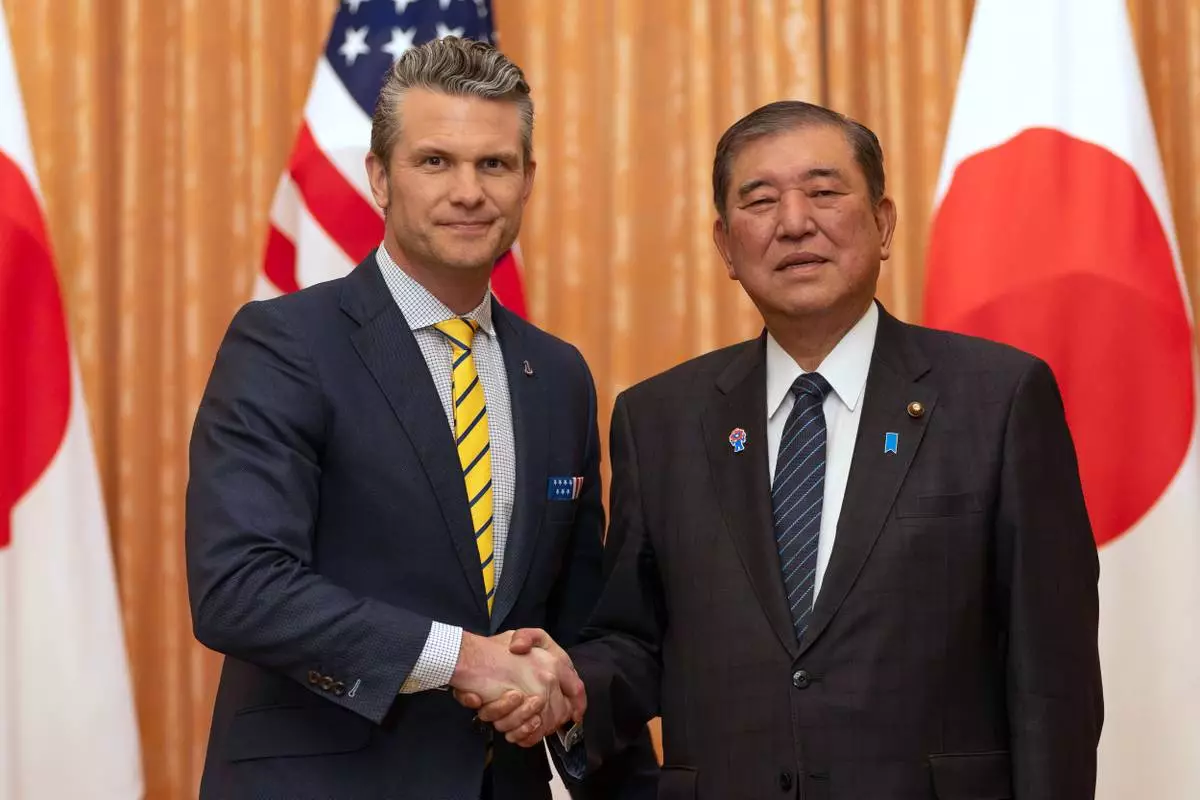
U.S. Secretary of Defense Pete Hegseth, left, shakes hands with Japanese Prime Minister Shigeru Ishiba at the prime minister's office in Tokyo Sunday, March 30, 2025. (Stanislav Kogiku/Pool Photo via AP)
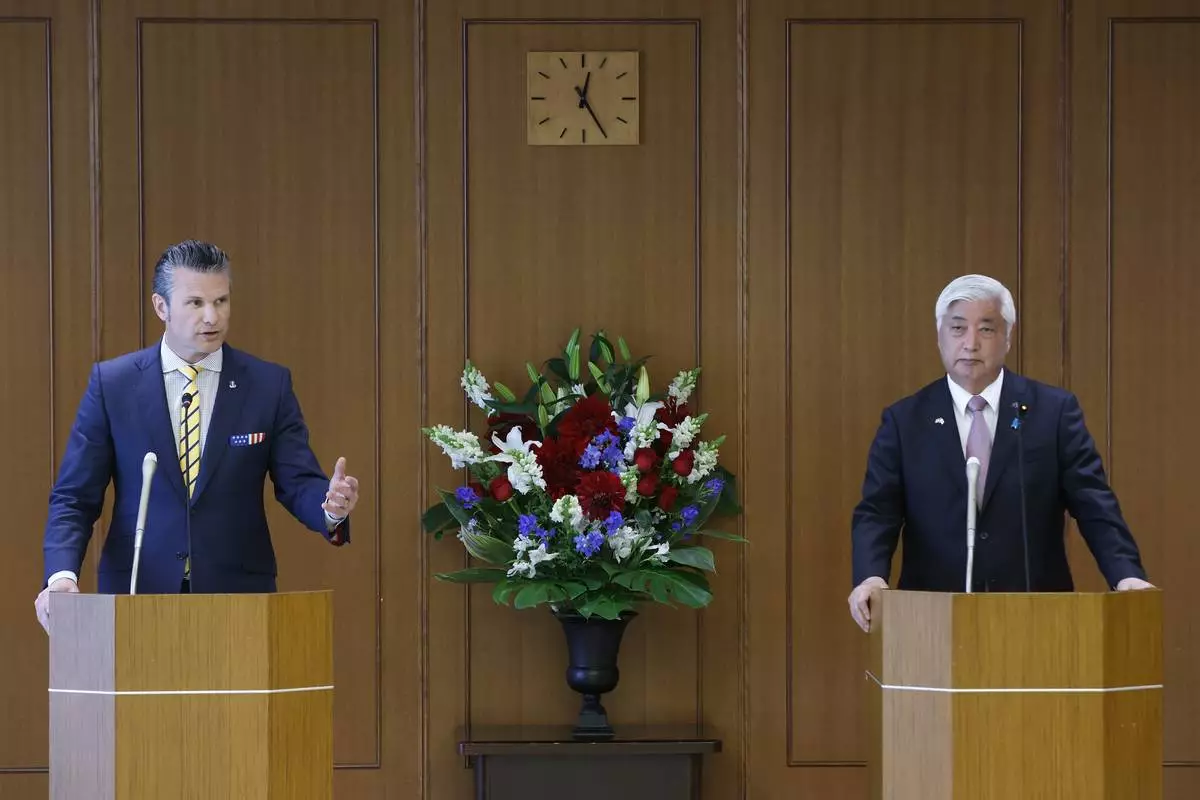
Japan's Defense Minister Gen Nakatani, right, and U.S. Secretary of Defense Pete Hegseth attend a joint news conference at the Ministry of Defense in Tokyo Sunday, March 30, 2025. (Kiyoshi Ota/Pool Photo via AP)
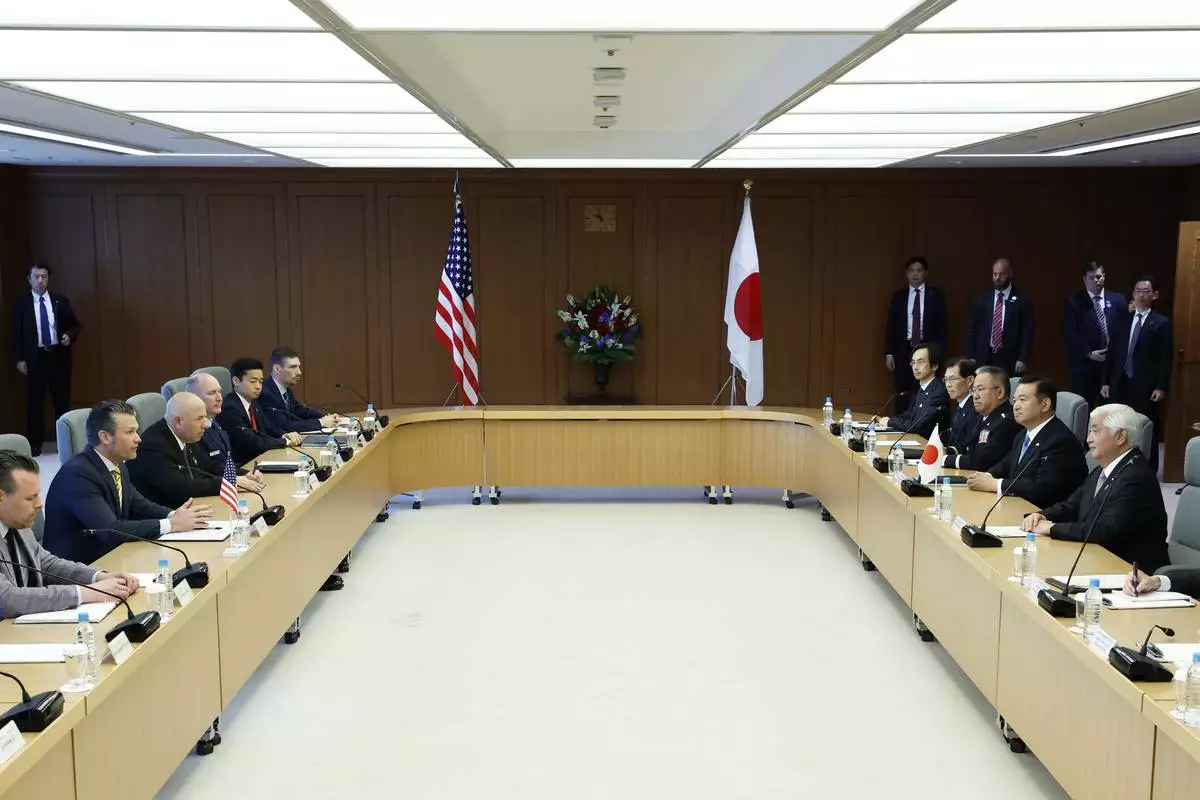
Japan's Defense Minister Gen Nakatani, right, and U.S. Defense Secretary Pete Hegseth, second left, meet at the Ministry of Defense in Tokyo Sunday, March 30, 2025. (Kiyoshi Ota/Pool Photo via AP)
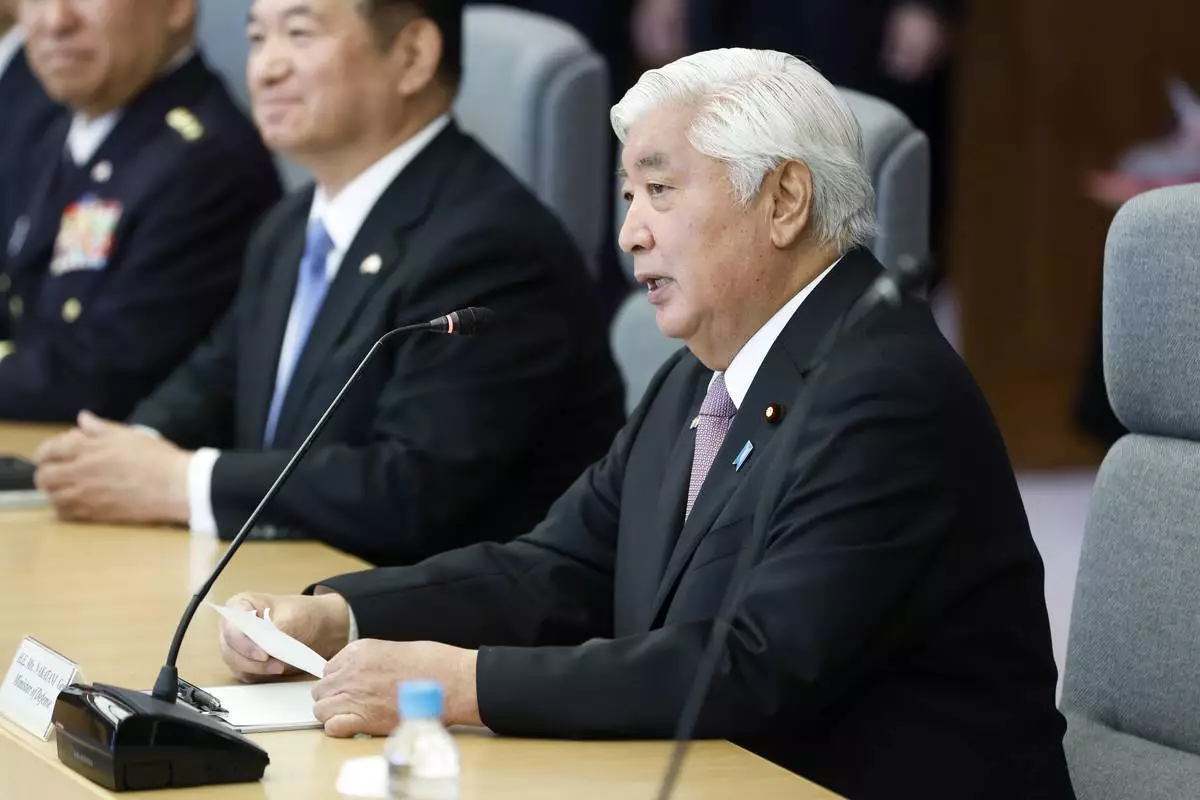
Japan's Defense Minister Gen Nakatani speaks with U.S. Defense Secretary Pete Hegseth, unseen, during their meeting at the Ministry of Defense in Tokyo Sunday, March 30, 2025. (Kiyoshi Ota/Pool Photo via AP)
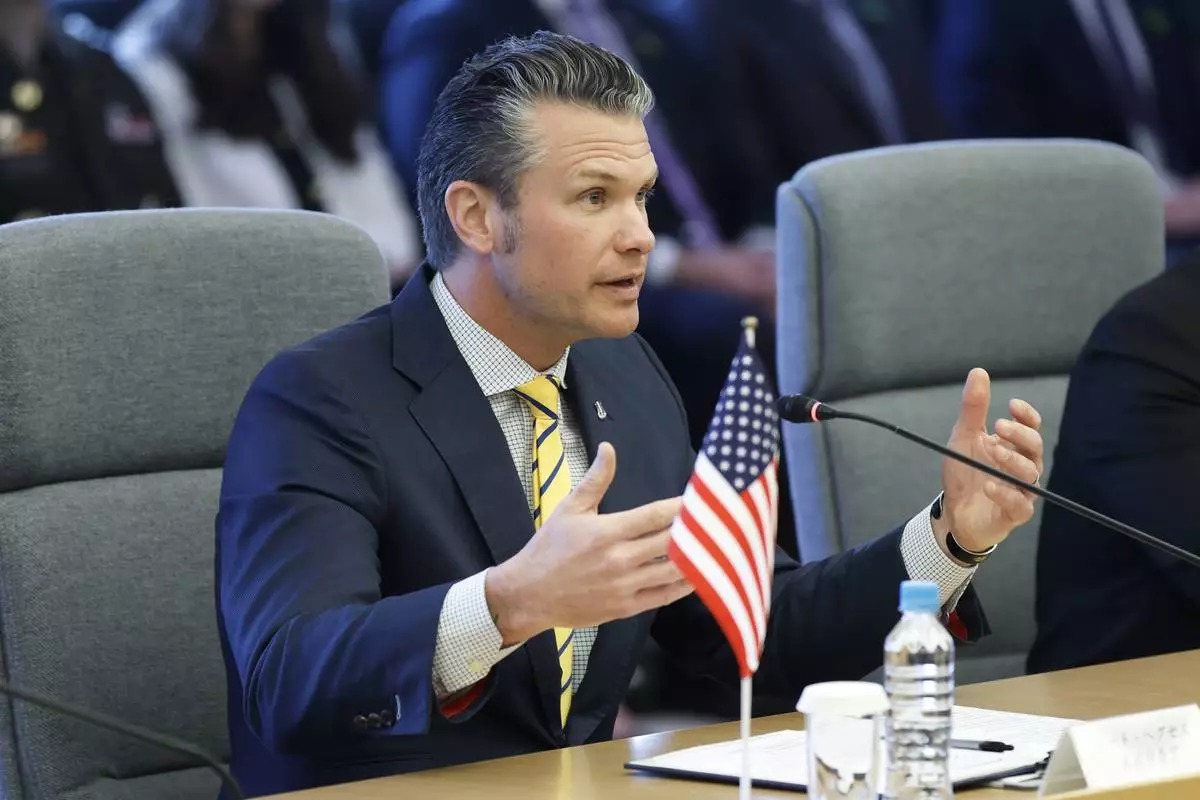
U.S. Defense Secretary Pete Hegseth speaks with Japan's Defense Minister Gen Nakatani during their meeting at the Ministry of Defense in Tokyo Sunday, March 30, 2025. (Kiyoshi Ota/Pool Photo via AP)
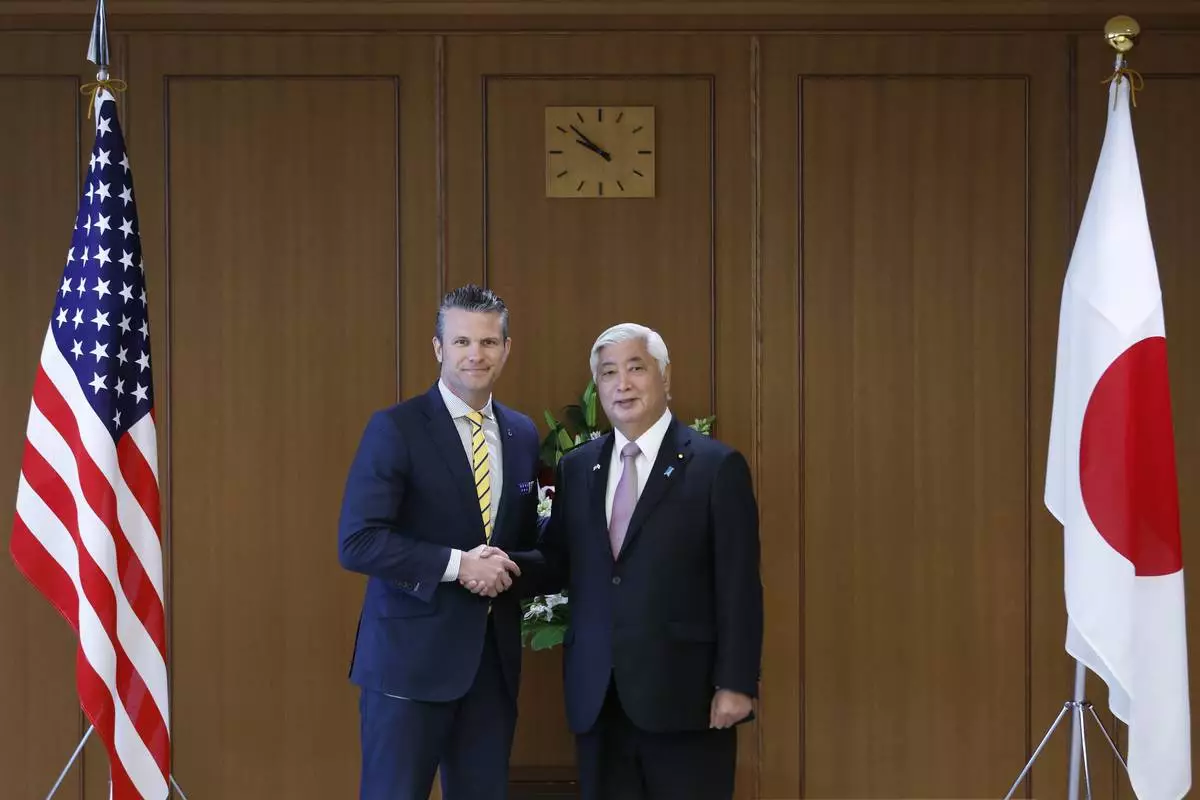
Japan's Defense Minister Gen Nakatani, right, and U.S. Defense Secretary Pete Hegseth shake hands while posing for photographs prior to their meeting at the Ministry of Defense in Tokyo Sunday, March 30, 2025. (Kiyoshi Ota/Pool Photo via AP)
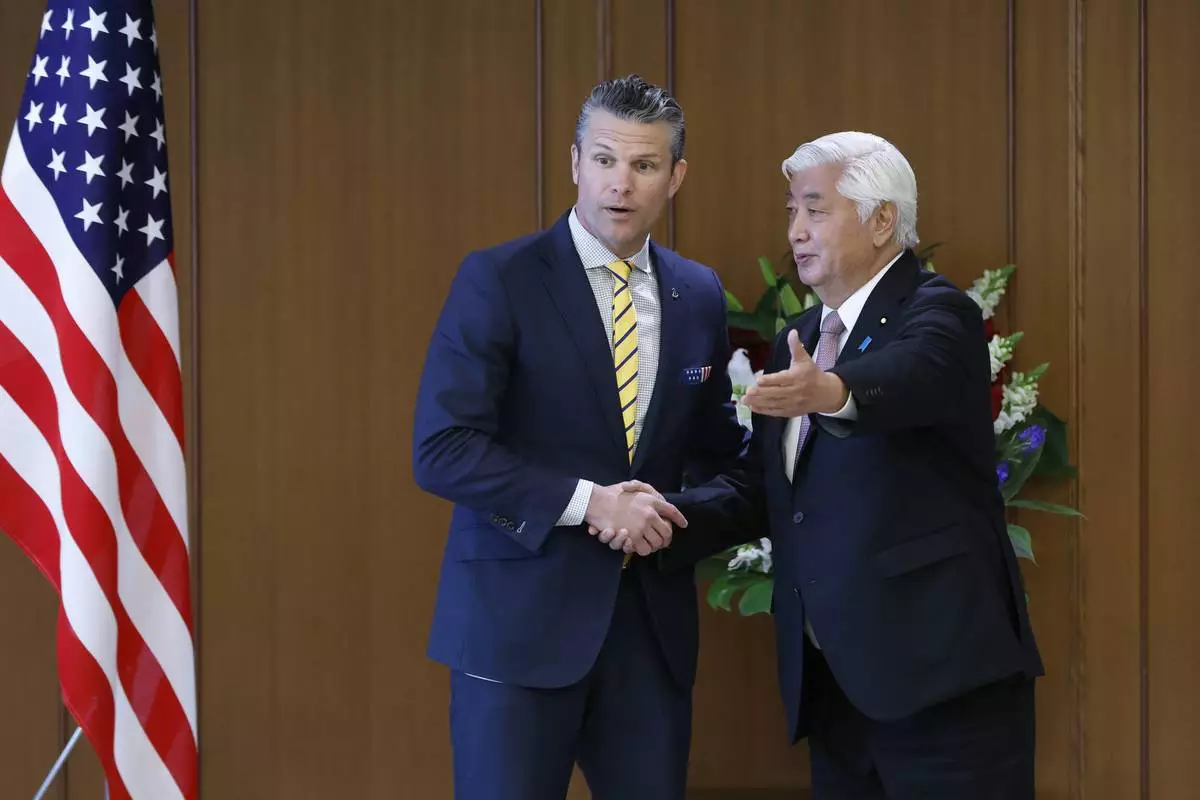
Japan's Defense Minister Gen Nakatani, right, and U.S. Defense Secretary Pete Hegseth meet at the Ministry of Defense in Tokyo Sunday, March 30, 2025. (Kiyoshi Ota/Pool Photo via AP)
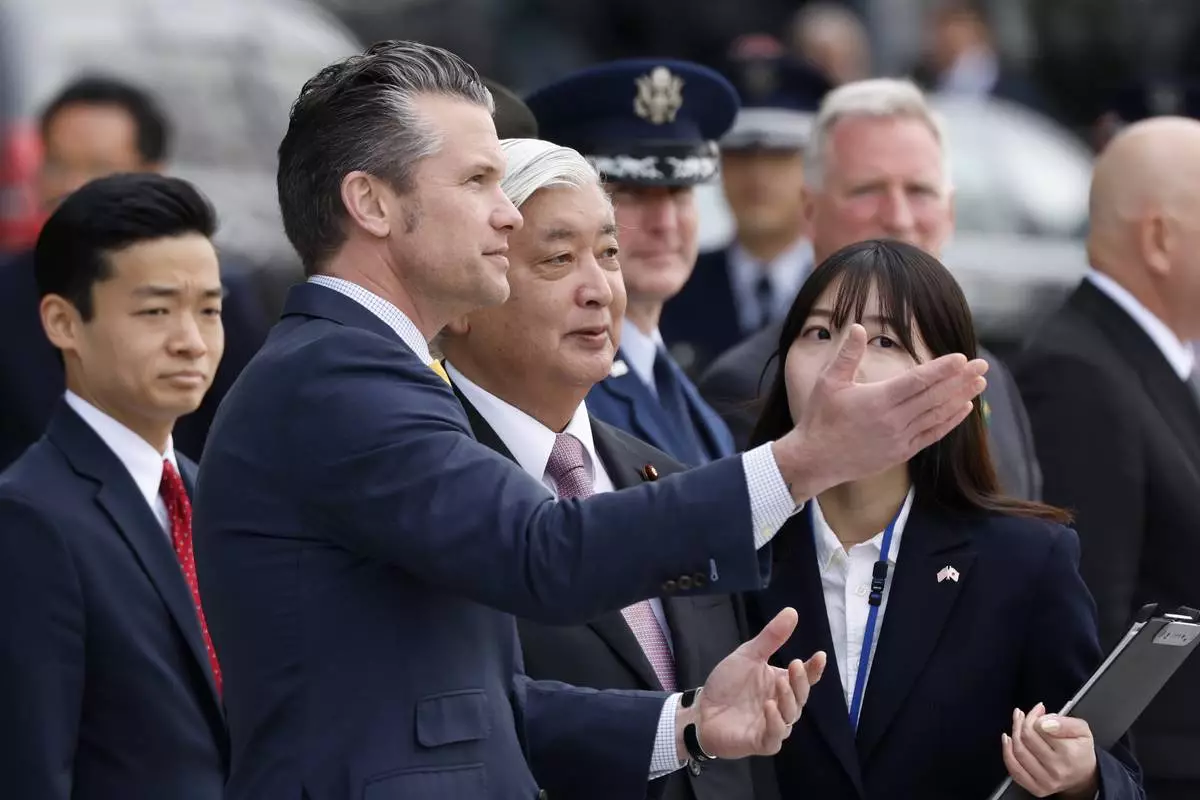
Japan's Defense Minister Gen Nakatani, center, and U.S. Defense Secretary Pete Hegseth, foreground, react after reviewing an honor guard during a welcome ceremony at the Ministry of Defense in Tokyo Sunday, March 30, 2025. (Kiyoshi Ota/Pool Photo via AP)
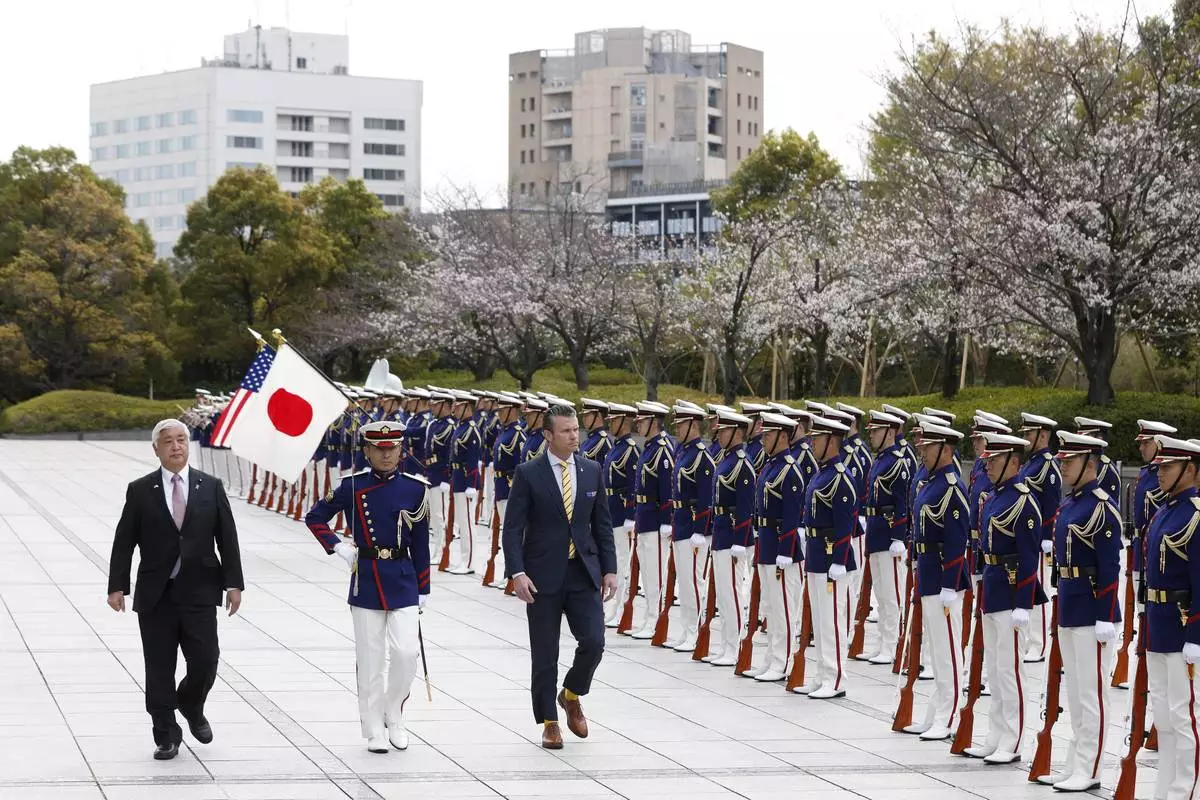
Japan's Defense Minister Gen Nakatani, left, and U.S. Defense Secretary Pete Hegseth, right, review an honor guard during a welcome ceremony at the Ministry of Defense in Tokyo Sunday, March 30, 2025. (Kiyoshi Ota/Pool Photo via AP)
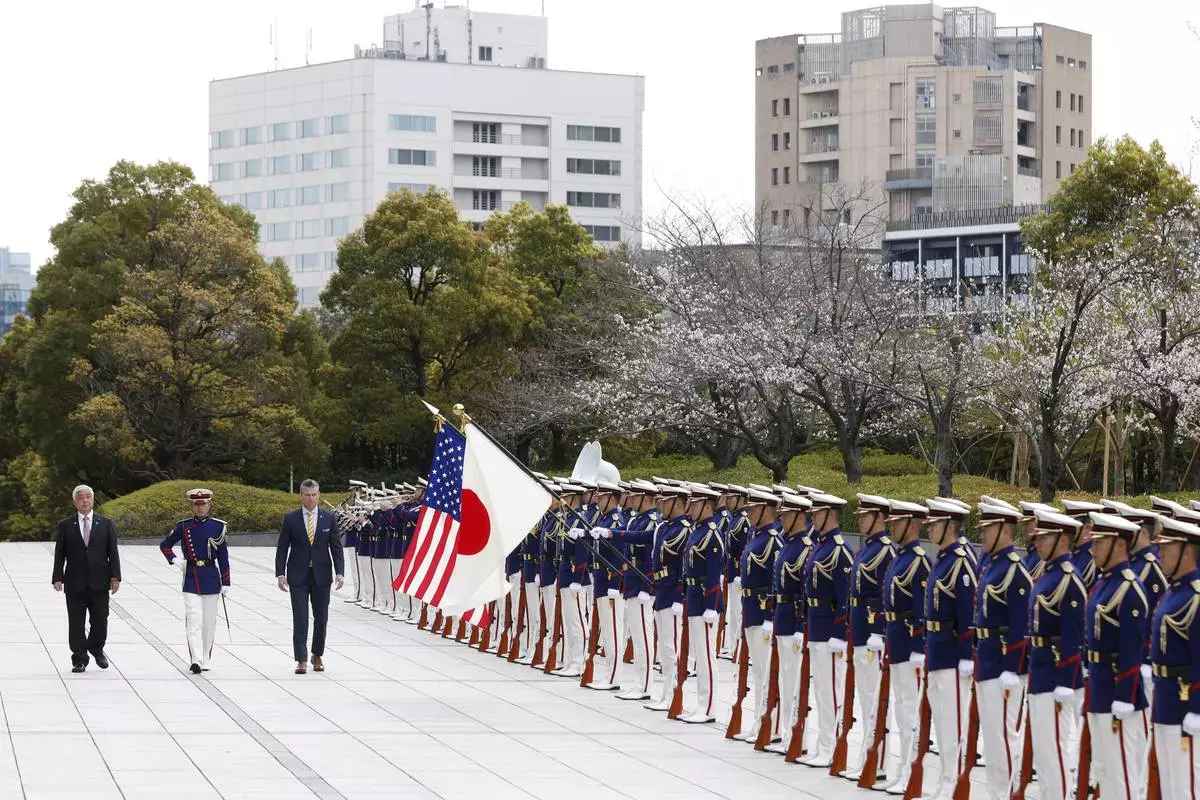
Japan's Defense Minister Gen Nakatani, left, and U.S. Defense Secretary Pete Hegseth, right, review an honor guard during a welcome ceremony at the Ministry of Defense in Tokyo Sunday, March 30, 2025. (Kiyoshi Ota/Pool Photo via AP)

Japan's Defense Minister Gen Nakatani, right, and U.S. Defense Secretary Pete Hegseth review an honor guard during a welcome ceremony at the Ministry of Defense in Tokyo Sunday, March 30, 2025. (Kiyoshi Ota/Pool Photo via AP)
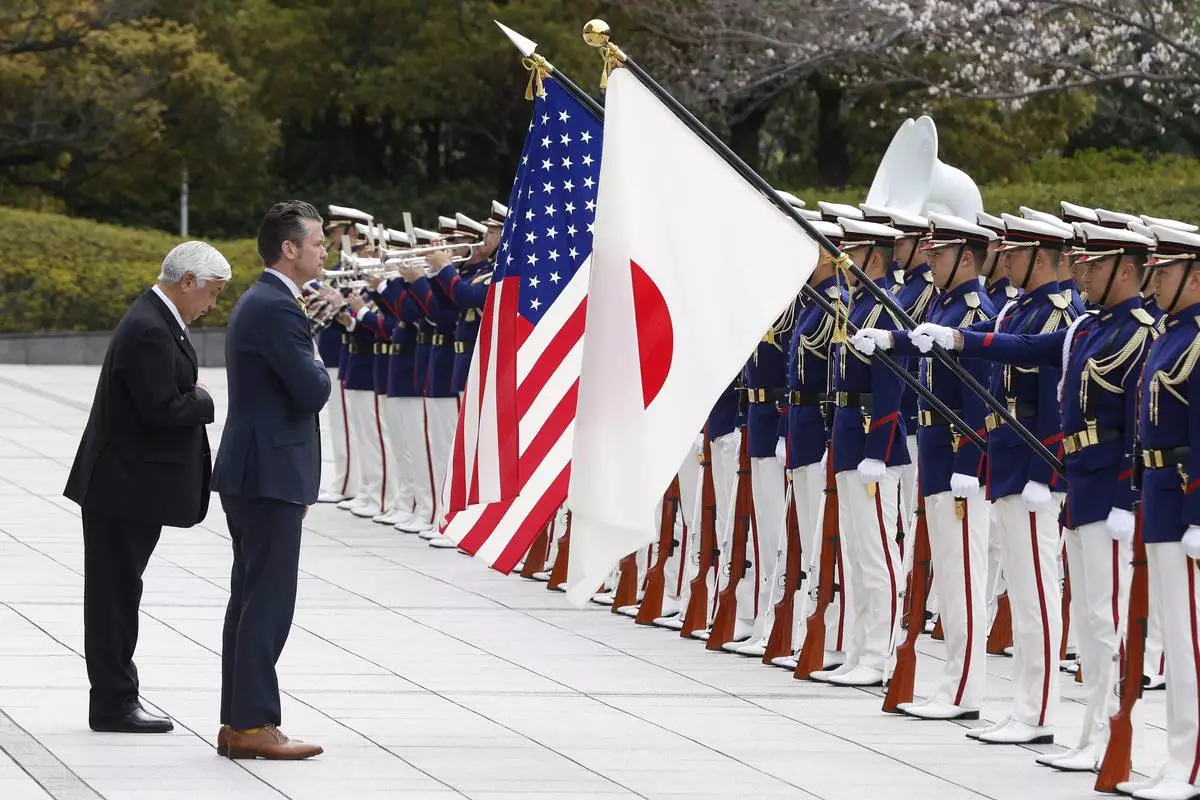
Japan's Defense Minister Gen Nakatani, left, and U.S. Defense Secretary Pete Hegseth review an honor guard during a welcome ceremony at the Ministry of Defense in Tokyo Sunday, March 30, 2025. (Kiyoshi Ota/Pool Photo via AP)
KYIV, Ukraine (AP) — A Ukrainian drone attack left at least seven people dead and a Russian strike on Odesa killed two people on Thursday, officials said, just hours after Kyiv and Washington signed a long-anticipated agreement granting U.S. access to Ukraine’s mineral resources.
The attack in the partially occupied Kherson region of southern Ukraine, which struck a market in the town of Oleshky, killed seven and wounded more than 20 people, Moscow-appointed Gov. Vladimir Saldo said.
"At the time of the attack, there were many people in the market,” Saldo wrote on Telegram. After the first wave of strikes, he said, Ukraine sent further drones to “finish off” any survivors.
Meanwhile, a Russian drone strike on the Black Sea port city of Odesa early Thursday killed two people and injured 15 others, Ukrainian emergency services said.
Regional Gov. Oleh Kiper said the barrage struck apartment buildings, private homes, a supermarket and a school.
Videos shared by Kiper on Telegram showed a high-rise building with a severely damaged facade, a shattered storefront and firefighters battling flames.
A drone struck and ignited a fire at a petrol station in the center of Kharkiv, Ukraine’s second-largest city, according to Mayor Ihor Terekhov.
Following the attacks, Ukrainian President Volodymyr Zelenskyy said that Russia had ignored a U.S. proposal for a full and unconditional ceasefire for more than 50 days now.
“There were also our proposals — at the very least, to refrain from striking civilian infrastructure and to establish lasting silence in the sky, at sea, and on land,” he said. "Russia has responded to all this with new shelling and new assaults.”
The U.S. and Ukraine on Wednesday signed an agreement granting American access to Ukraine’s vast mineral resources, finalizing a deal months in the making that could enable continued military aid to Kyiv amid concerns that President Donald Trump might scale back support in ongoing peace negotiations with Russia.
Tymofiy Mylovanov, former economy minister and current president of the Kyiv School of Economics, said Thursday that despite what he described as “unimaginable pressure” during negotiations on the newly signed minerals deal, Ukraine succeeded in defending its interests.
“This is a huge political and diplomatic win for Ukraine,” Mylovanov wrote on Facebook. “All the draconian demands of the other side were canceled. The deal looks fair.”
Mylovanov said the deal includes no requirement for Ukraine to repay previous U.S. aid, nor does it restrict Kyiv to selling only to American buyers. Instead, he said, the deal recognizes contributions from both sides: Ukraine’s in the form of revenues from new projects, and the U.S. potentially through military assistance.
Kyiv residents voiced mixed reactions Thursday morning to the newly signed U.S.-Ukraine agreement, with many saying they had not yet had time to fully understand the deal’s implications.
Among those who spoke to The Associated Press about the deal was Diana Abramova, who attended a rally in Independence Square demanding information on missing Ukrainian soldiers. Her father, Valentyn Stroyvans, went missing in combat last year.
“Any news is hard to take — whether it’s about negotiations or anything else,” Abramova said. “But I still believe and hope that any action will bring us closer to one thing: Ukraine’s victory. Only victory.”
Seventy-four-year-old university lecturer Natalia Vysotska said she wasn’t familiar with the details of the agreement but remained cautiously optimistic.
"I don’t know what the terms are — they may not be favorable for Ukraine at all. Still, if it was signed, our experts must have weighed the pros and cons. I hope it will be beneficial.”
Others shared a more skeptical view. Iryna Vasylevska, a 37-year-old Kyiv resident, expressed frustration and disillusionment with the broader implications of the deal.
She told the AP she feels terrible that “our land is just a bargaining chip for the rest of the world and that we do not have our own full protection, but rely on someone.”
“My vision is that instead of strengthening ourselves, we continue to give it all away. I feel sorry for our land and for our people,” she said.
Reaction to the signing was generally muted in Moscow on Wednesday, a holiday in Russia. But the deputy chair of Russia’s National Security Council, Dmitry Medvedev, said that Trump had forced Ukraine to effectively “pay” for American military aid with its mineral resources.
“Now military supplies will have to be paid for with the national wealth of a disappearing country," he claimed in a post on Telegram.
Vladimir Rogov, chairman of the Russian Civic Chamber’s commission on sovereignty, told Russian state news agency RIA Novosti that Zelenskyy had effectively handed Ukraine over to “legally prescribed slavery.”
A previous version of this story incorrectly stated that Russia's Defense Ministry reported shooting down eight Ukrainian drones overnight on Sunday. The statement was made on Thursday.
Follow AP’s coverage of the war in Ukraine at https://apnews.com/hub/russia-ukraine
Morton reported from London.
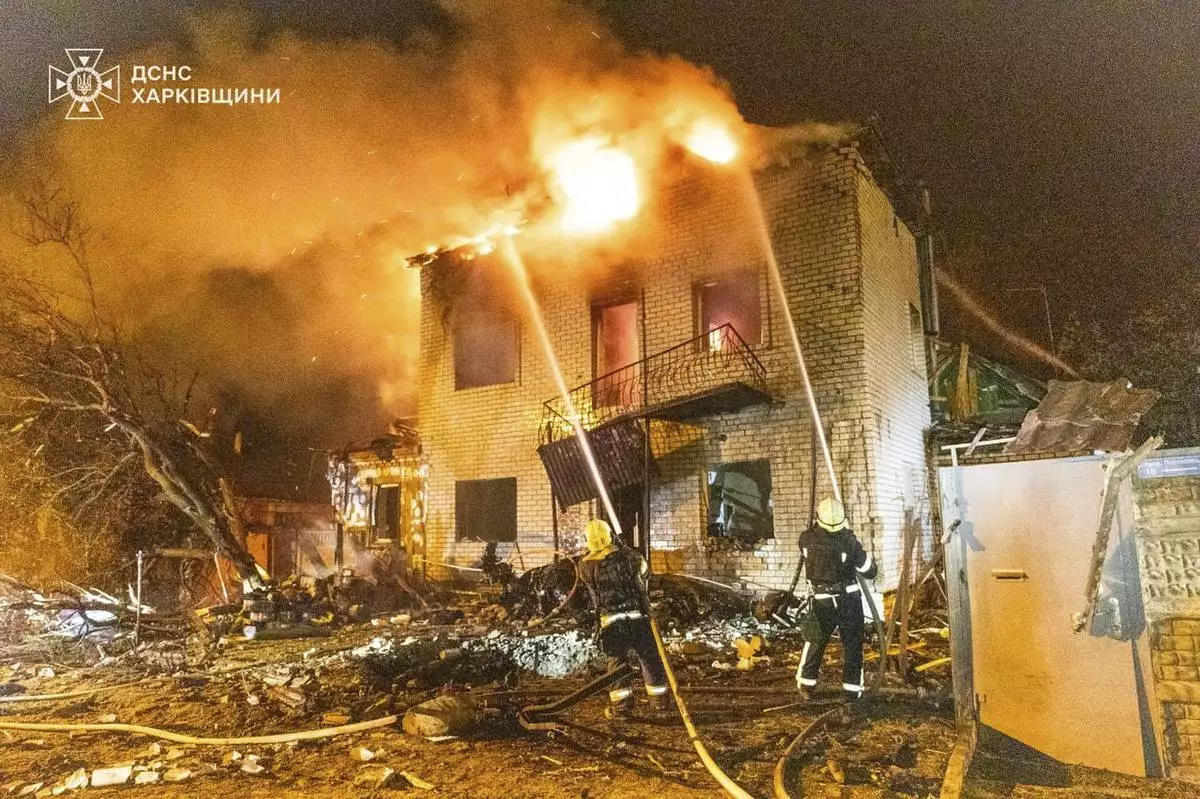
In this photo provided by the Ukrainian Emergency Service, emergency services personnel work to extinguish a fire following a Russian attack in Kharkiv, Ukraine, Wednesday, April 30, 2025. (Ukrainian Emergency Service via AP)


















